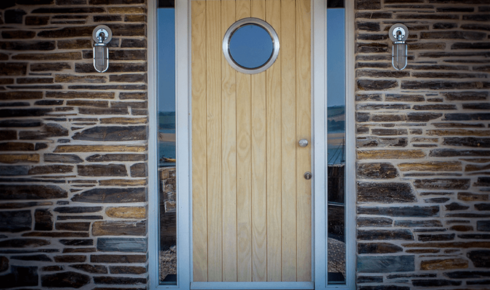Step into any well-designed home, and you’ll notice something. Amid all the sleek marble countertops, polished tiles, and shining steel fixtures, there’s usually a touch of wood. It might be a single window frame, a dining table passed down through family, or a grand front door that has seen decades of footsteps. Timber has this way of anchoring a space, giving it soul, even when surrounded by the cold precision of modern materials.
There’s a reason people keep coming back to it. Timber isn’t just about function. It’s about feeling. About memory. About creating spaces that don’t just look impressive in a magazine photo but feel good to actually live in.
The door that makes an entrance
If walls are the bones of a house, then the front door is its handshake. It sets the mood before you’ve even crossed the threshold. Think about it: how many times have you visited a house where the door alone made an impression? That gentle creak, the sturdy weight, the smell of polished wood—it all speaks louder than any welcome mat.
That’s where Solid Timber Entrance Doors come into play. They don’t just separate outside from in; they invite. They hold a presence you don’t get from hollow composites or mass-produced PVC. A timber door is reliable, grounding, and honest. It’s not pretending to be something it’s not. And over time, as weather, sunlight, and hands shape it, it begins to tell its own story—a quiet witness to the life inside the house.
Windows that frame more than light
Now, shift your gaze from the entrance to the way a house looks out onto the world. Windows aren’t just holes in the wall for air and daylight—they’re frames for experiences. And when you look through Timber Frame Windows, you notice the difference. There’s warmth where there might otherwise be sterility. The timber softens the light, almost filtering it into a glow, while also adding texture that’s missing from synthetic alternatives.
Picture this: a winter afternoon, you’re curled up with a book, the sunlight slipping in through timber-framed glass. The edges catch the light, casting soft shadows on the floor. It feels cozy in a way that aluminum or PVC just can’t replicate. Timber windows don’t only connect you to the outside—they remind you that natural materials have a place inside, too.
A craft that carries tradition
Of course, none of this happens by accident. Timber isn’t poured into molds like plastic or stamped out like metal. It needs shaping, joining, patience. And that’s part of its charm. Every carpenter, every joiner, is making small decisions based on the grain, the strength, even the quirks of the wood in their hands.
This makes each piece a little unique. A corner that fits just so, a joint polished smooth, an edge left with a trace of character. It’s not industrial sameness—it’s craftsmanship. And while machines might assist, the essence of timber work remains human. You can sense the hours, the skill, and even the respect put into the making.
The “imperfections” that make it better
Skeptics will point out that timber has its flaws. It swells in humidity. It can fade in the sun. Sometimes it creaks when the house shifts with the seasons. But are those really flaws? Or are they reminders that timber is alive, that it responds to the world around it?
I’ve always thought that’s the beauty of it. The squeak in the floorboards that tells you where your kids are sneaking down the hall. The deepening tone of a wooden stair that has seen years of footsteps. The faint scratches that add texture rather than diminish beauty. Wood ages like we do—gaining character with time.
Caring for something worth keeping
Yes, timber does ask for maintenance. Sanding, sealing, maybe the occasional polish. But honestly, isn’t that part of the deal with anything we value? A leather jacket you wear for decades. A garden you tend through seasons. Relationships that need time.
Timber is the same. It rewards the care you give it by lasting longer, looking richer, and feeling more like it belongs. Compare that to the “maintenance-free” materials that crack, peel, or simply lose charm after a few years—and suddenly, timber’s demands don’t seem like burdens at all.
Timber as the greener option
Another thing worth noting: timber is kinder to the planet than most alternatives. Harvested responsibly, it’s renewable, unlike plastics or energy-intensive metals. Every piece of timber stores carbon, keeping it locked away instead of floating around in our atmosphere.
And unlike synthetic options that often end up as waste, timber can be reused, repurposed, even recycled into new forms. It’s part of a longer story, one that doesn’t end at a landfill but can keep unfolding in new shapes and functions.
Emotional architecture
What keeps drawing people back to timber, though, isn’t just practical or environmental arguments—it’s the emotional side. Timber feels alive. A door that groans slightly in winter, a window frame that glows in evening light, a staircase that grows smoother with every hand that touches it. These small changes connect us to time, to memory.
They remind us that homes aren’t meant to stay perfect. They’re meant to live, breathe, and gather marks of the life happening inside them. Timber, unlike any other material, embraces that role fully.
A place for timber today
It’s not about building entire log cabins anymore (though there’s charm in that too). Timber today shows up in bold statements—massive entry doors, exposed ceiling beams—or in subtle accents, like a single frame or countertop that warms an otherwise sterile design.
Architects pair it with concrete for contrast, with glass for lightness, with steel for strength. Timber adapts, slips into modern life with quiet ease, without losing its grounding presence. It’s versatile, but it never stops being itself.
Final thoughts
At the end of the day, timber is more than a building material. It’s memory made tangible. It carries craft, warmth, and a touch of nature into spaces that might otherwise feel cold. A house with timber in it—whether it’s the front door, the windows, or even a single well-placed beam—just feels more like home.
In a world rushing toward disposable, prefabricated everything, timber slows us down. It insists on care, rewards patience, and ages gracefully alongside us. That’s why, even as trends shift and technologies advance, wood remains. Because it doesn’t just build structures—it builds stories.

